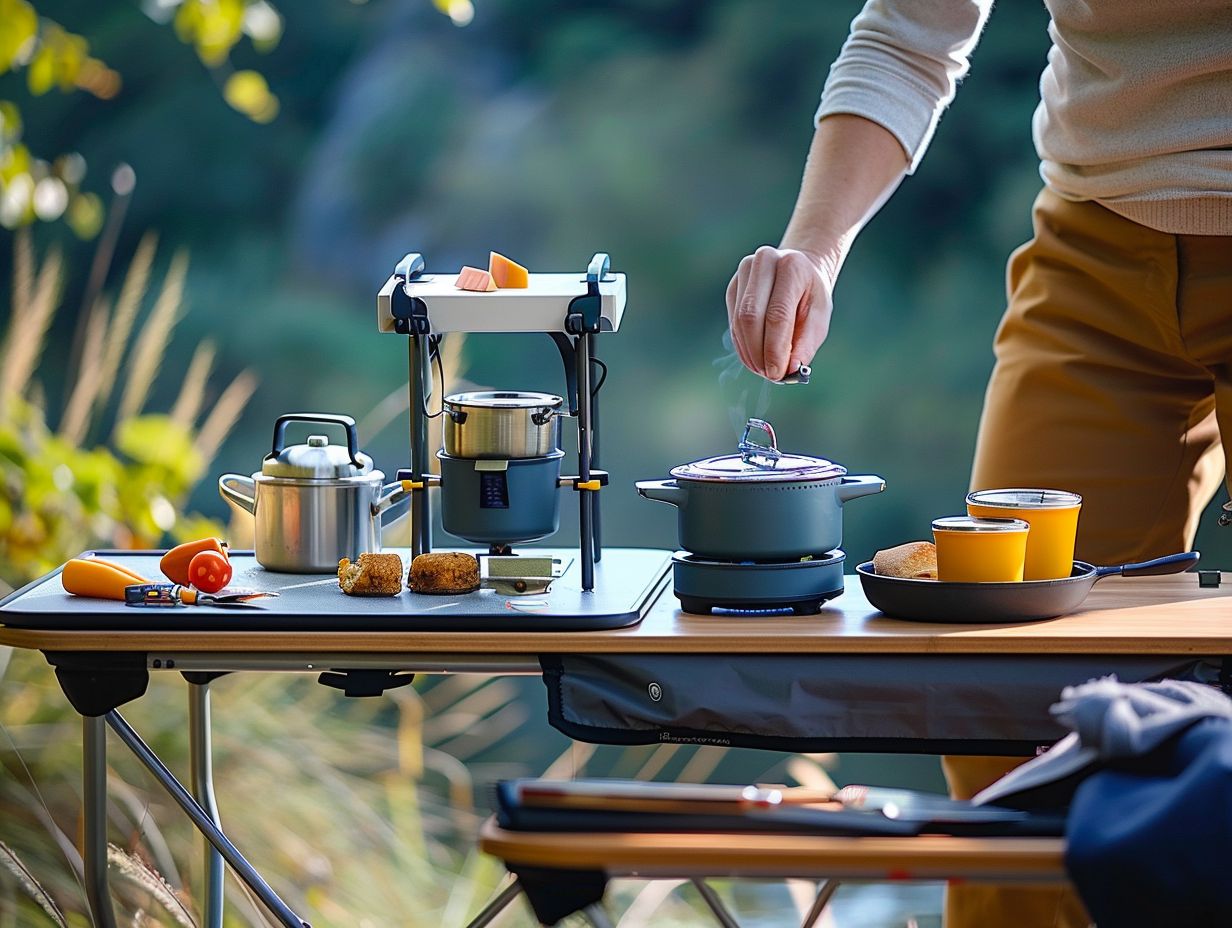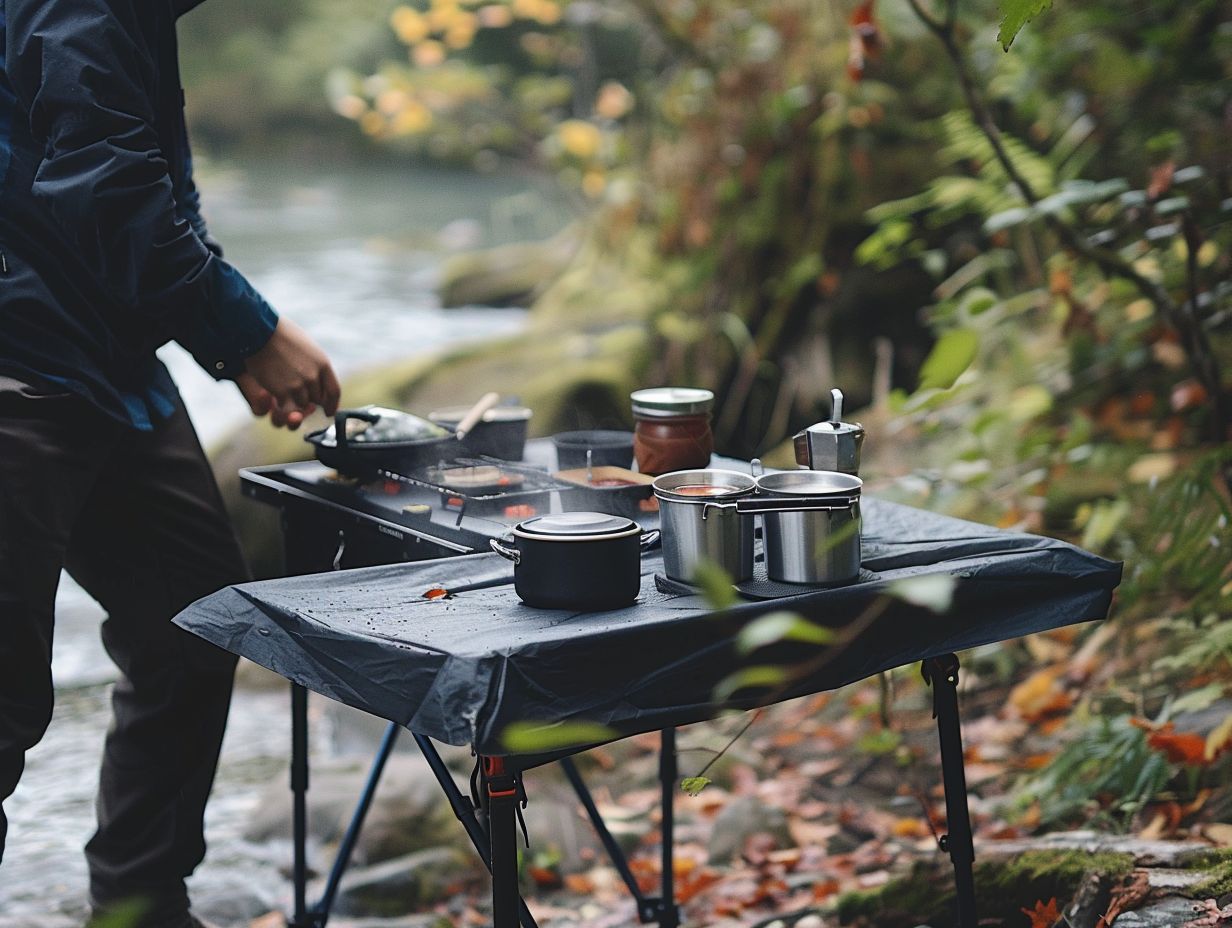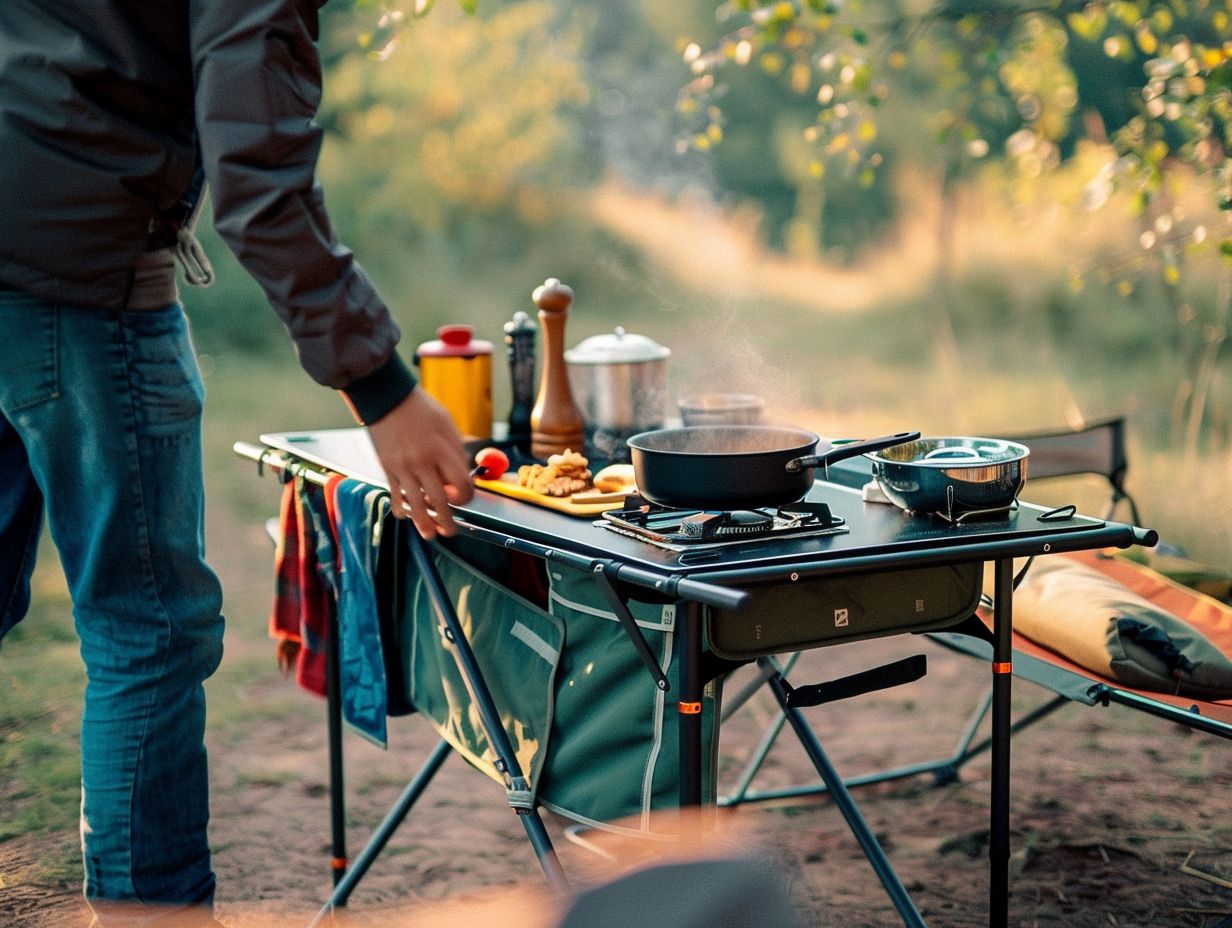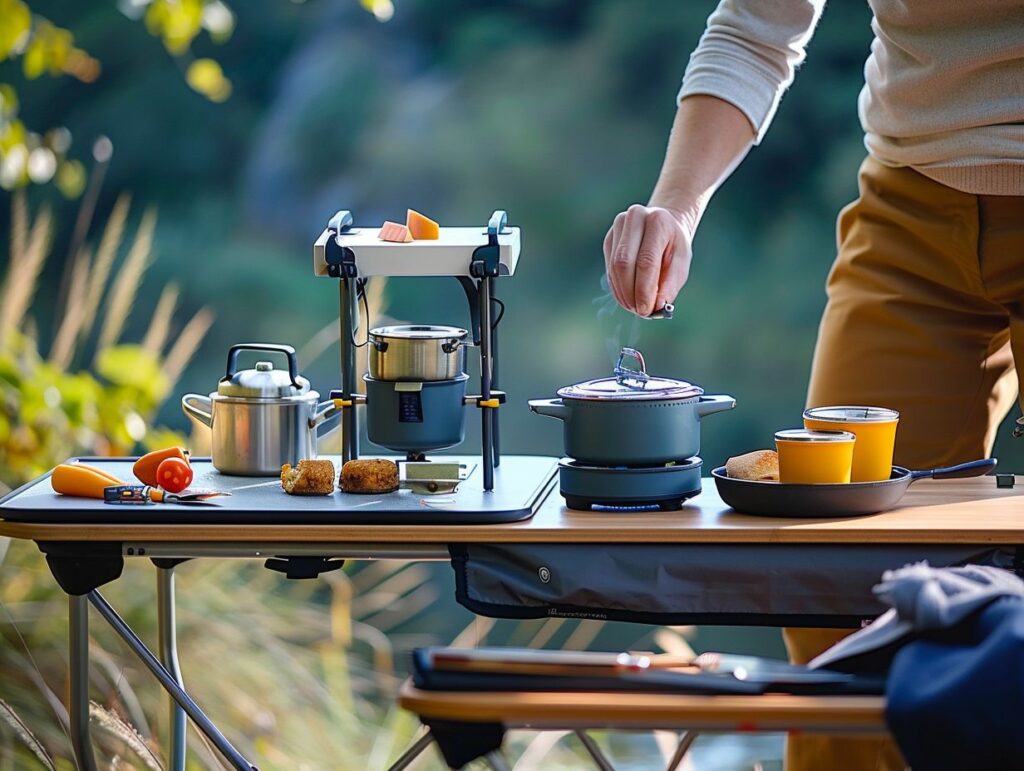Are you an outdoor enthusiast looking to enhance your camping experience? Setting up a camp kitchen can make a world of difference in your outdoor adventures.
This article covers the essential items needed for a camp kitchen, from cooking equipment to food storage containers. We also provide step-by-step instructions on setting up your camp kitchen and offer tips for maintaining it.
Learn what to do with food scraps and leftovers while camping by staying tuned!
Key Takeaways:

- Choose a suitable location for your camp kitchen to ensure safety and convenience.
- Properly store and dispose of food to maintain cleanliness and prevent attracting animals.
- Be prepared with essential items such as cooking equipment, utensils, and cleaning supplies to set up a functional camp kitchen.
How to Set Up a Camp Kitchen
Setting up a camp kitchen requires careful planning and organization to ensure the availability of all essential ingredients and equipment, including a camping stove and an Aeropress, to facilitate a successful outdoor cooking activity.
1. Choose a Suitable Location
Selecting an appropriate site for the camp kitchen necessitates a careful evaluation of safety measures and proximity to the camping area, while also ensuring a safe distance from potential wildlife encounters.
Another critical aspect to consider is choosing a location that is at an optimal distance from the sleeping quarters, striking a balance between accessibility and convenience. Additionally, it is advantageous to identify a spot that offers natural protection against the elements, such as a natural windbreak or shade.
Emphasising the importance of siting the camp kitchen on sturdy ground to minimise environmental impact cannot be overstated. It is imperative to maintain a harmonious equilibrium between safety, convenience, and sustainability in the establishment of the camp kitchen.
2. Gather and Organise Supplies
The gathering and organisation of supplies represent a crucial preparatory stage in establishing a functional camp kitchen, guaranteeing that all utensils and equipment are readily accessible. An effective strategy for maintaining the organisation of your camping kitchen involves the utilisation of storage solutions, such as transparent plastic containers or portable organisers.
Ahead of packing, it is advisable to group similar items together to facilitate ease of location. Devising a comprehensive checklist of essential items can also prove beneficial in ensuring that all necessary supplies are accounted for, thereby minimising the risk of omitting any crucial components.
Employing a methodical approach to arrangement results in enhanced efficiency during the camping expedition, enabling individuals to allocate their time and efforts towards deriving enjoyment from the natural surroundings.
3. Set Up Cooking Area
The preparation of the cooking space involves the methodical arrangement of the camp stove and accompanying tools in an efficient and secure manner, with the recommendation of utilising esteemed brands such as Coleman.
Once a suitable location has been selected for the camp stove, it is imperative to ensure placement on a level surface, distanced from any combustible materials.
Positioning the stove downwind from the cooking area is advised to mitigate the effects of wind interference. The arrangement of cooking implements, including pots, pans, and utensils within close proximity, facilitates easy accessibility.
The utilisation of reputable brands like Coleman not only guarantees durability but also ensures optimal functionality during outdoor culinary pursuits.
Prioritising safety is essential, hence the recommendation of having a fire extinguisher or a bucket of water readily available for prompt response to emergencies.
4. Set Up Eating Area
The process of establishing the dining area involves the arrangement of furniture and tableware to establish a comfortable dining environment for meals.
During the setup of this designated area, it is important to strategically position the dining table in a central location that allows effortless access for all individuals. Ensuring that chairs are placed in a manner that accommodates each camper comfortably around the table is essential.
The meticulous arrangement of placemats, utensils, and glasses on the table can contribute to an aura of organisation and sophistication within the space. By integrating subtle decorative elements such as candles or flowers, a warm and welcoming ambiance can be cultivated, enhancing the dining experience amidst the outdoor setting.
It is imperative to recognise that the presence of a designated eating space not only elevates the overall camping experience but also contributes to the maintenance of a tidy and structured campsite.
5. Set Up Washing Area
The washing area should be equipped with a designated cleaning station and a dependable water supply in order to facilitate efficient dishwashing and post-meal cleanup.
The cleaning station should be stocked with essential items such as dish soap, scrub brushes, sponges, and dish towels to facilitate a thorough cleaning process. It is imperative to ensure convenient access to a water supply, whether through a sink with running water or a nearby bucket of water.
Adherence to best practices for dishwashing involves the removal of food scraps prior to washing, the utilisation of hot water for enhanced cleaning efficacy, and the air-drying of dishes to mitigate the risk of cross-contamination.
Sustaining cleanliness within the washing area is paramount for mitigating the transmission of germs and upholding food safety standards. An orderly washing area fosters a hygienic environment by minimising the likelihood of contamination and streamlining cleaning procedures.
Tips for Maintaining a Camp Kitchen

The maintenance of a camp kitchen requires regular cleaning, suitable food storage, and safety measures to ensure a pleasant and hygienic cooking environment.
1. Keep It Clean
Maintaining cleanliness in the camp kitchen is essential for promoting hygiene and ensuring safety, and the use of products such as Dr. Bronner’s is recommended for eco-friendly cleaning purposes.
Consistent dishwashing plays a critical role in preventing the proliferation of harmful bacteria in areas where food is prepared and on utensils. Alongside washing dishes promptly post-use, it is imperative to routinely sanitise countertops and cooking surfaces. Employing natural cleaning agents like vinegar and baking soda can prove effective in eliminating stubborn stains.
To uphold hygiene standards in the outdoor setting, it is advised to refrain from leaving food exposed for prolonged periods and to store all provisions in securely sealed containers to deter animals. Proper disposal of waste and immediate cleanup of spills are additional measures that can aid in averting contamination and maintaining a pristine and secure campsite.
2. Properly Store Food
Proper food storage practices, such as utilising airtight containers and refrigeration when feasible, are imperative in preventing spoilage and guaranteeing food safety.
When establishing a camp kitchen, it is critical to allocate a specific area for food storage. It is advisable to segregate raw meats from other food items to prevent cross-contamination.
Clear containers are recommended for easy visibility and access to food supplies. Proper labelling of containers with dates is essential to monitor freshness and avoid consumption of expired products.
Additionally, the consideration of acquiring insulated coolers or portable refrigerators for perishable items is highly recommended. By upholding an organised food storage system, not only does one enhance efficiency in meal preparation but also mitigates the potential risks of foodborne illnesses during outdoor excursions.
3. Dispose of Waste Properly
Proper waste disposal is of utmost importance in maintaining a hygienic and safe environment within a camp kitchen, a practice that serves to safeguard both individual health and the integrity of the surrounding ecosystem.
In the context of waste management within a camp kitchen, it is imperative to recognise the nuanced nature of waste categorisation. Specifically, food scraps necessitate careful collection and subsequent disposal in assigned composting facilities to mitigate the potential for attracting wildlife to the area.
Conversely, packaging materials require segregation for the purpose of recycling or removal from the campsite to prevent any inadvertent littering. Adherence to such protocols, in conjunction with a steadfast commitment to Leave No Trace principles, enables campers to contribute towards the preservation of the natural landscape’s aesthetics while simultaneously minimising their ecological footprint.
What to Do with Food Scraps and Leftovers?
Proper management of food scraps and leftovers is essential to avoid attracting animals and maintain cleanliness at the campsite.
1. Pack Out What You Can
Proper waste management is crucial when engaging in outdoor activities. It is highly recommended to utilise designated containers such as rubbish bags, reusable bins, or containers to facilitate the separation of different types of waste.
Categorising waste into recyclables, compostables, and general rubbish streamlines the disposal process and promotes environmentally-friendly practices. Hazardous items like broken glass should be stored in puncture-proof containers to minimise the risk of injury during transportation.
To reduce waste generation, individuals should consider using reusable items in place of single-use products. Bringing items such as a water bottle, utensils, and cloth bags can substantially decrease the volume of waste generated during outdoor activities.
2. Burn What You Can’t Pack Out
Disposing of waste through burning is a potential method of waste management; however, it is imperative to approach this practice cautiously to prioritize safety and environmental preservation.
When engaging in waste burning activities, it is essential to adhere to specific conditions. It is advised to burn only those materials that are deemed safe for combustion and that will not release harmful toxins or pollutants into the atmosphere. Materials such as plastics, rubber, or treated wood should be avoided due to their potential to emit toxic fumes.
Selecting a well-ventilated location that is distanced from structures and vegetation is crucial, whilst also verifying the absence of any burn bans or restrictions in effect. Equip oneself with necessary tools including a shovel, water source, and fire extinguisher to address potential emergencies.
Strict monitoring of the fire is imperative, with an emphasis on never leaving the fire unattended. Following the completion of the burning process, ensure the fire is fully extinguished, and dispose of the resulting ashes in a designated area to minimise environmental impact.
3. Bury What You Can’t Burn

Disposal of waste that cannot be incinerated or packed out necessitates the consideration of carefully managed burial practices to prevent environmental harm.
When opting for burial as a waste disposal method, meticulous attention must be given to the depth and location of the burial site. It is imperative that the waste is buried at a depth of several feet to prevent exposure and potential contamination of groundwater or soil.
Selecting a burial location that is distanced from bodies of water and implementing proper drainage systems to mitigate leachate are critical aspects to be taken into account.
To minimise waste accumulation, it is highly recommended to prioritise waste reduction, reuse, and recycling efforts wherever feasible. Practices such as composting organic waste and donating usable items serve as effective means of reducing the volume of waste that necessitates burial.
Embracing alternatives to waste burial, such as recycling, repurposing, and adopting the use of eco-friendly products, can significantly contribute to the reduction of overall waste generation and promote sustainable waste management practices.
Frequently Asked Questions
What items do I need to set up a camp kitchen?
To set up a camp kitchen, you will need a cooking stove, pots and pans, utensils, plates, bowls, cups, a cooler, a camping table, and a wash basin. You may also want to bring along a portable water filter and a tarp for shade and protection from the elements.
Where is the best location to set up a camp kitchen?
The best location for a camp kitchen is a flat and level area close to your campsite. Look for a spot with natural shade or bring along a tarp to provide shade. It’s also important to choose a spot that is away from your sleeping area and any potential hazards like cliffs or bodies of water.
How should I organize my camp kitchen?
The key to a well-organized camp kitchen is to have a designated spot for each item. Keep frequently used items like cooking utensils and spices within easy reach and group similar items together. Use storage bins or containers to keep everything organized and easily accessible.
What are some safety precautions I should take when setting up a camp kitchen?
When setting up a camp kitchen, always make sure to follow proper food safety guidelines. Keep raw meat and other perishable items in a separate cooler from drinks and other non-perishable items. Use caution when using a camp stove, and keep it away from flammable materials. Always clean up any spills or messes to avoid attracting wildlife.
How do I clean and maintain my camp kitchen equipment?
Properly cleaning and maintaining your camp kitchen equipment will help it last longer and ensure your future camping trips are well-equipped. Wash all dishes and utensils with soap and hot water after each use. Wipe down your cooking stove and other surfaces with a disinfectant cleaner. Allow everything to dry completely before packing away. When you return home, thoroughly clean and dry all equipment before storing it away for your next trip.
What are some tips for setting up a camp kitchen on a budget?
If you’re trying to set up a camp kitchen on a budget, there are a few tips to keep in mind. Look for sales or secondhand equipment, and consider borrowing or renting items from friends or family. Instead of buying pre-packaged camping meals, bring ingredients to cook simple and budget-friendly meals. You can also repurpose household items, such as using a plastic bin as a wash basin or a cutting board.

